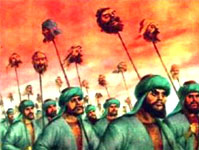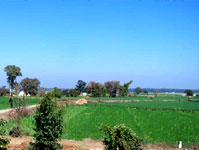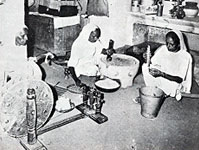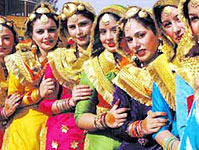Jor Mela |
Sirhind, its Mughal legacy evident in the ruined but beautiful mosques and tombs among which it has grown, was the site almost 300 years ago, of a victory commemorated by the Fatehgarh Sahib Gurudwara. The blood and thunder of the battle is an inseprable facet of the history of the proud and martial Sikhs. But so is sacrifice and suffering. For this serene place of worship also marks the martyrdom of Guru Gobind Singh's two young sons who were entombed alive here by the Mughals. Today it is an important center of pilgrimage, drawing the devout to pay homage to theirGurus. This religious fervour culminates in the excuberant festivities of the Jor Mela, when hundreds of thousands of people gather here in remembrance and devotion, Hymns and recitations of the holy epics by folk minstrels and poets blend with the lilting cadences of rustic song, music.
|
 |
| Baisakhi |
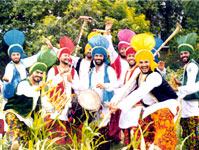 |
Baisakhi usually falls on 13th April or occasionally on the following day. In Amritsar, at Baisakhi there is a great sale of animals and many Sikhs travel on trailers behind tractors or by Bus. This is one of the times of harvest in Punjab and it is a generally accepted Sikh tradition to celebrate Baisakhi and then begin gathering in the grain crops.Naturally, before they set out for home they not only worship at the Golden Temple but also visit other historic sites, such as Jallianwala Bagh where the massacre of 1919 intensified demands for Indian independence from the British. The first amrit initiation ceremony was held at Anandpur, because it is the town is usually respectfully called Anandpur Sahib today. Also although the ceremony may be held anywhere and at any time. Throughout the Sikhs world the covering (Chola) on the flag mast (Nishan Sahib) outside the Gurudwara will be changed at Baisakhi. In many places where there is large population of Sikhs the Guru Granth Sahib will be taken around the town on a lorry or some similar open vehicle. Five men on horseback or on foot - the Panj piare - carrying small nishan sahib will lead the procession. Children dressed as panj piare may follow and then, after the float will come many members of the Sikh population, some walking some on carts singing kirtan to the accompaniment of musicians. This celebration is known as Nagar Kirtan. |
|
 |
| Diwali |
|
|
 |
Diwali is a moveable festival because it is based on the lunar calendar. This was the second mela to which Guru Amar Das summoned his Sikhs. It marks the end of the financial year for businessmen and women. For many North Indian Hindus, however it principally commemorates Price Rama's return to his capital city of Ayodhya with his faithful wife Sita,after their years of exile Tradition says that the inhabitants illuminated the lamps. These, bonfires, and fireworks, are major features of the celebration today. Their brightness shines out all the more strongly in Indian villages because the four day festival begins at the end of the dark part of the month of Ashvina, three days before the new moon and the first day of month of Kartik. Sikhs have their own Diwali story. Guru Hargobind enjoyed variable relationship with the Emperor Jehangir. Sometimes they haunted together but in 1619 he was in prison in Gwalior. His release was ordered just before the Diwali festival. The Guru refused to accept his freedom unless 52 imprisoned Hindu rajas could leave him with. The emperor agreed that he could take as many with him as could hold on to his cloak while he passed through a narrow postern gate. The Guru has long tassels attached to his cloak the rajas held on to them and everyone was freed. His safe arrival at the Harmandir Sahib in Amritsar was welcomed by Sikhs who decorated it, and the surrounding pool, with lamps. Now days Diwali the precincts of the Golden Temple are outlined with electric illumination and usually they, or traditional clay lamp and candles, will also be found on the steps and in the entrance of Gurudwara. The fourth day of Diwali is a Hindu festival dedicated to Vishvakarman and observed by craftsmen. |
|
|
|
 |
| Lohri |
|
  |
Like Basant and Baisakhi is a seasonal festival observed chiefly in the Punjab. It falls in mid - January, when sun touches the southern - most point on the ecliptics and duration of the night is the longest. The word Lohri seems to be derived from Loh and Ari, literally meaning Iron foe or black foe. A week ago before the Lohri young boys and girls go from house to house asking for money, sweets and firewood.While going from house to house the boys and girls sing doggerels. On the Lohri night bonfire's are made in household and in public streets Small quantity of peanuts, popcorn, parched rice, sesamum seed, gur and sweets are thrown into the fire as offerings, and also eaten by people who sit sing and gossip around the fire. The Lohri fire is symbolic of the homage to the sun. There is another version of Lohri that in the olden times human times human beings lit fire to keep away flesh eating animals and to protect their habitants. The Lohri bonfire is symbolic of our old methods of protecting ourseleves as well as a form of fire worship. It is Lohri that couples pray for their childrens, and home where there is newborn son, or newly married person, the Lohri is celebrated with more enthuiasm. For peasants the Lohri marks the beginning of new financial year because on this day they settle the division of the produce of land between themselves and the tiller. Lohri songs are based on Dulla of Bhatti village.
|
|
 |
| Basant Panchami |
|
|
Is spring time. Basant Panchami falls on the fifth day of the bright half of Magh. The festival marks the commencement of the spring season. In many part of India it is observed as a mere secular holiday, with no celebration connected with it. According to the Hindu scripture, Basant Panchami is sacred to Saraswati, the goddess of literature and fine arts. Basant Panchami is also associated with the worship of Vishnu, god of preservation. On this day fairs are held and kite flying takes place. Most of the people wear basanti (yellow) turbans and caps and childrens also usually dress in yellow clothes. Kite flying on this day is so popular that the blue sky is filled with multicoloured kites. In Punjab the festival is also associated with the Martydoms of the Hakikat Rai who on this day laid down his life, for not accepting the Muslim faith under coercion. In this way Basant Panchami is celebrated with fairs and humorous atmosphere all around the Punjab. |
|
 |
| Gurupurabs |
|
|
The majority of Sikhs festivals are Gurpurabs, anniversaries of Gurus, birthdays and occasionally deaths, plus the anniversary of the first installation of the Adi Granth. Sikhs celebrate them in the same way wherever they live. The main activity is a continuous reading of the Guru Granth Sahib an Akhand Path which is timed to take Forty eight hours and ends on the morning of the day when Gurpurabs is being observed usually on Sundays. Readers work in relays with stints of no more than two hours at a time. A reader will always be ready to take over should theperson reading be taken ill. There is no difficulty in finding readers unless a sangat is small and has few members who can read Guru Granth Sahib with correct intonation. |
|
|
 |
| Maghi Mela |
| Maghi is a Sikh festival celebrated on the first day of the month of Magh of Bikrami calendar. It falls on 14
January, a day after the Lohri festival which is very popular in Punjab. The Maghi festival commemorates the martydom of thr "Chalis Mukte" (the forty Immortals) who died fighting the Moghul forces near Muktsar. Guru Gobind tore the deed of disclaimer executed by his Sikhs and granted pardodn to them for their repentence and sacrifice. It is one of the biggest fairs of the Sikhs. It is associated with Guru Gobind Singh and his forty followers from the Majha tract. The fair began about 200 years agoand starts every year, the day before lohri and finishes a day after Lohri. In 1704 Guru Gobind Singh and his men stood besieged at Anandpur Sahib fort, as they were running short of food about forty of his followers left him and went home. Their womenfolks taunted them leaving their leader. One of the women, named Bhago, put on male clothes and went to help Guru. The forty men followed her to apologize the Guru. On their way to Muktsar they met Mughal army and fought with gallantly and died one by one saving the Guru. Guru cremated these forty warriors, at the site where now Gurudwara Shaheed Ganj stands. He named the place where they died fighting is called Muktsar. |
|
|
 |
Hola Mohalla |
|
|
Anandpur Sahib comes to life every year on the occasion of Hola Mohalla. This tradition dates back to the times of the 10th Guru, Sri Guru Gobind Singh . The Guru decreed that the occasion of the festival of Holi be the occasion for the display of the martial spirit of his people and he gave this festival of Holi the Sikh name of 'Hola Mohalla'. Each year Hola Mohalla marks the congregation of up to 100,000 devotees from all over the country for a festival of colour and gaiety.Thousands of devotees from various parts of the country throng to Anandpur Sahib to participate in the fair which lasts for three days. The Gurudwaras are specially decorated for the occasion. During Hola Mohalla Anandpur Sahib wears a festive appearance and hums with activities in the month of March every year. Community conferences and religious functions are also organized. |
|

